Think you have to choose between loving cats and breathing freely? Think again. While millions of people suffer from cat allergies—thanks mostly to the Fel d 1 protein found in cat saliva, dander, and skin oils—not all felines are created equal when it comes to triggering those telltale sniffles and sneezes. Some cat breeds naturally produce less of this allergen, while others have special coat types that shed less and carry fewer irritants into the air. The result? A group of allergy-considerate cats that are beautiful, affectionate, and a whole lot easier to live with.
This list covers 15 cat breeds that are known to be better for allergy-prone households—from elegant longhairs that barely shed to quirky short-coated cats with almost no dander. Whether you’ve always dreamed of owning a cat but held back because of your sinuses, or you’re just looking to avoid turning your couch into a fur trap, these breeds bring the love without the allergic overload. We’ll walk you through their coats, personalities, histories, and why they might just be the breath-of-fresh-air companion you’ve been waiting for.
1. Siberian Cat
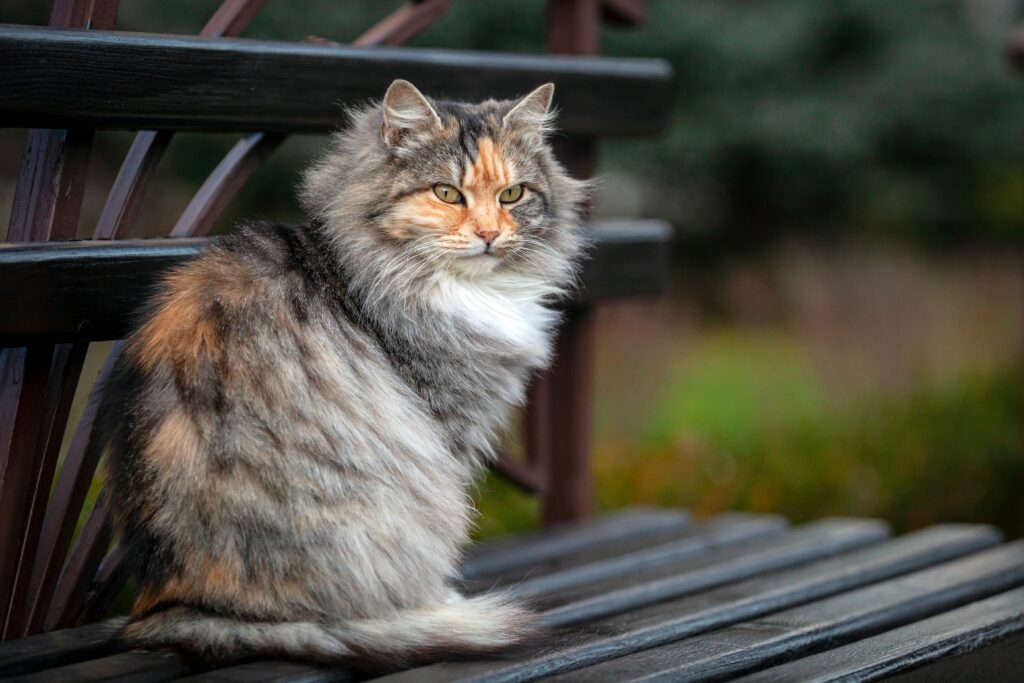
With their enormous triple coat, lion-like ruff, and snowshoe paws, the Siberian cat looks like it would leave your home and your sinuses covered in fur. But surprisingly, these forest-born fluffballs are among the most allergy-considerate cats on the planet. Native to the icy woodlands of Russia, the Siberian developed a dense, water-repellent coat to withstand harsh climates—but beneath all that fluff lies a game-changing trait: many produce far less of the Fel d 1 protein, the primary allergen in cat saliva and dander. A 1999 study confirmed some Siberians produce up to 20 times less than average. Their thick coat also sheds in bursts rather than year-round, meaning fewer allergens floating through the air on a daily basis.
Siberians have been part of Russian folklore for centuries, said to guard children in their sleep and protect homes from evil spirits. Despite their long domestic history, they weren’t introduced to the West until the 1980s, and by the ‘90s, they had captured the attention of breeders and allergy sufferers alike. Once in the U.S., breeders began developing lines specifically for temperament and low-allergen qualities. While no breed is completely hypoallergenic, many Siberians are naturally cleaner, lighter shedders, and their fur doesn’t mat easily despite its volume. A weekly brushing is often all they need, and their grooming habits tend to be less obsessive than some short-haired breeds.
What surprises most allergy-prone cat lovers is how easy the Siberian is to live with. They’re playful but not hyper, affectionate without being clingy, and have a gentle confidence that makes them excellent with kids, other pets, and first-time cat owners. Their purr is deep and rumbling, their gaze steady and intelligent, and their ability to leap to the top of a bookshelf without knocking anything over is the stuff of legend. For anyone who thought “long-haired” meant “off-limits,” the Siberian is a beautiful exception—and a breath of fresh air.
2. Balinese
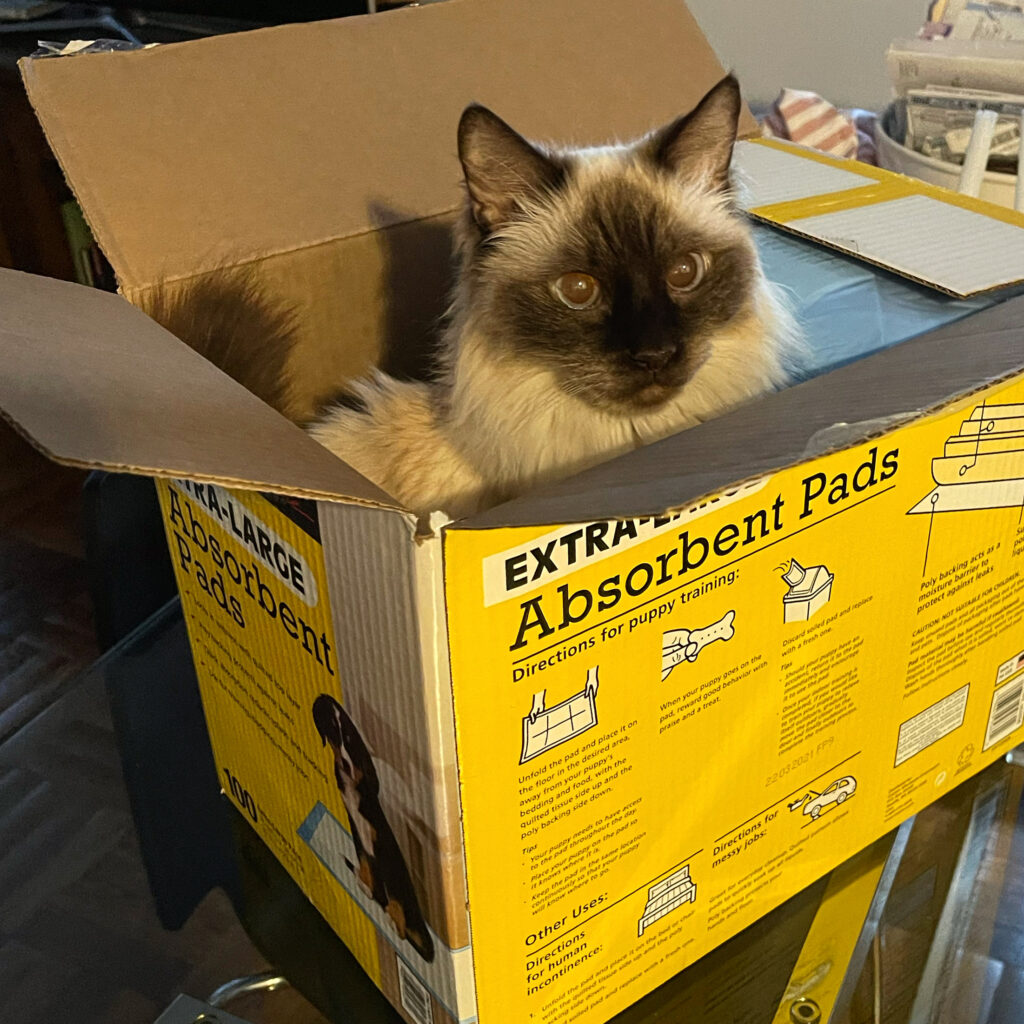
Have you ever owned or wanted a cat with the elegance of a ballerina and the sass of a talk show host? Meet the Balinese, affectionately nicknamed the “long-haired Siamese,” and surprisingly one of the lowest Fel d 1-producing cat breeds. With a single-layer coat that’s fine and silky, Balinese cats don’t shed much and aren’t prone to trapping dander or saliva. This combination of low allergen production and low-maintenance fur makes them a dreamy choice for sensitive cat lovers who still want glamour and affection.
Balinese cats emerged in the early 20th century as a natural mutation in Siamese litters, but it wasn’t until the 1950s that breeders in the U.S. began developing the line intentionally. The name “Balinese” was chosen for their graceful, dancer-like movements—not any geographical link to Bali. Their coats, while longer than the Siamese, are still minimal and don’t require constant brushing—just a quick groom now and then to stay soft and sleek. They’re considered one of the few long-haired breeds with real allergy appeal.
But their personality is just as impressive as their coat. Balinese cats are vocal, affectionate, and thrive on human interaction. They’ll carry on conversations with you, follow you through the house, and cozy up on your lap with total confidence. If you want a cat who looks like a cloud, acts like a best friend, and won’t have you reaching for antihistamines, the Balinese is a hypoallergenic dream wrapped in silk.
3. Bengal

If you’ve ever dreamed of owning a tiny leopard, the Bengal is your fantasy come to life—minus the jungle, and maybe minus the sneezing too. With its striking rosettes and marbled markings, this cat looks fierce but is full of affection. What makes Bengals allergy-considerate isn’t just their sleek, pelt-like coat that sheds minimally—it’s also the texture of that fur, which traps less dander and dries faster after grooming, reducing saliva spread. While they’re not officially hypoallergenic, many allergy-prone owners say Bengals don’t trigger the same reactions as other breeds.
The Bengal was born from a cross between a domestic cat and the small, wild Asian leopard cat in the 1960s, originally as a conservation effort. But the breed quickly became popular for its exotic look and playful personality. Over the years, breeders refined them to be more sociable and family-friendly while keeping their wild edge. That short, dense coat not only gives them their distinctive shimmer—it also requires little maintenance. A quick weekly brushing is enough to keep them sleek and allergen-light.
These cats aren’t content to nap all day. Bengals are smart, athletic, and endlessly curious. They love climbing, exploring, playing with water, and inventing games—often ones that involve your socks or your houseplants. They form strong bonds with their humans and often act more like dogs than cats, greeting you at the door and sticking close by. For anyone looking for a hypoallergenic-ish cat with bold style, boundless energy, and an affectionate heart, the Bengal is a wild little wonder.
4. Devon Rex

With giant ears, high cheekbones, and a pixie-like grin, the Devon Rex looks like a cat drawn by a mischievous daydreamer—and its coat is just as unique. This breed has only the soft, downy undercoat (no guard hairs at all), which means way less shedding and fewer allergens floating through the air. Many people with cat allergies find Devons much easier to tolerate, especially since their short, curly fur traps less dander and dries quickly after grooming. Some even produce less Fel d 1, the main culprit behind itchy eyes and sneezing fits.
The breed began in Devonshire, England, in 1960, when a naturally curly-coated kitten named Kirlee was born to a stray. Breeders recognized the mutation as something special and worked to preserve the trait, creating a line of cats that felt like suede and looked like space aliens. Their coat is delicate—more like peach fuzz than traditional fur—so over-brushing isn’t needed or advised. A soft cloth wipe or occasional bath is all it takes to keep them clean and allergen-friendly.
Beyond the coat, Devon Rexes are total charmers. They’re playful, loyal, and often prefer shoulder perches to sofas. They love being involved in everything you do—cooking, reading, Zoom meetings, you name it. They’ll chase toys with giddy abandon and then curl up like a warm, purring bean. For allergy sufferers looking for a cat that feels magical, acts ridiculous, and won’t leave fur storms in its wake, the Devon Rex is a delightfully oddball option.
5. Oriental Shorthair
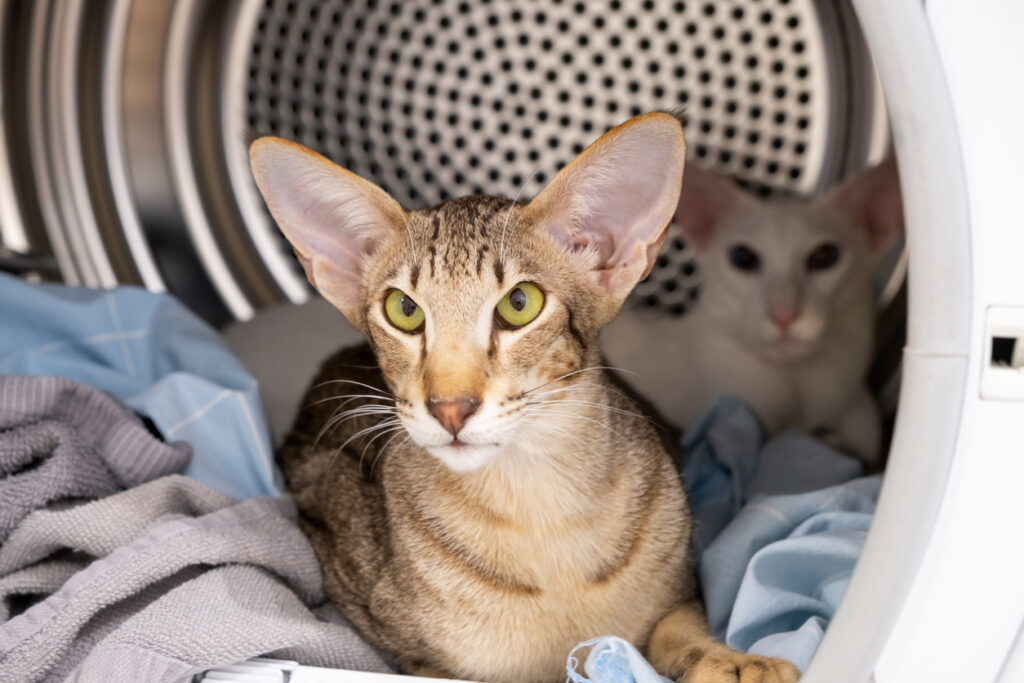
With its sleek build, oversized ears, and dramatic stare, the Oriental Shorthair is basically the runway model of the cat world—and a surprisingly smart pick for allergy-prone pet lovers. A close cousin of the Siamese, this breed shares the same low-shedding, ultra-fine coat that hugs the body and doesn’t hold much dander or saliva. Many also produce lower levels of Fel d 1, making them easier on the immune system than most fluffier breeds.
The Oriental Shorthair was developed in the 1950s and ’60s by crossing Siamese cats with British and American Shorthairs to introduce a wider range of colors and patterns. The result? Over 300 possible coat combinations—from solid black to tortoiseshell to colorpoint—with the same graceful lines and chatty personality of their Siamese roots. Their fur requires almost no maintenance, and their fastidious grooming habits keep things even cleaner. Weekly wipe-downs or brushing are more than enough.
These cats are as full of personality as they are opinions. Oriental Shorthairs are talkative, affectionate, and often form intense bonds with their humans. They’ll follow you from room to room, chat with you like a best friend, and entertain you with their acrobatic antics. If you want a cat that’s expressive, elegant, and far less sneeze-inducing than most, the Oriental Shorthair brings brains, beauty, and breathability in one fine-coated package.
6. Russian Blue
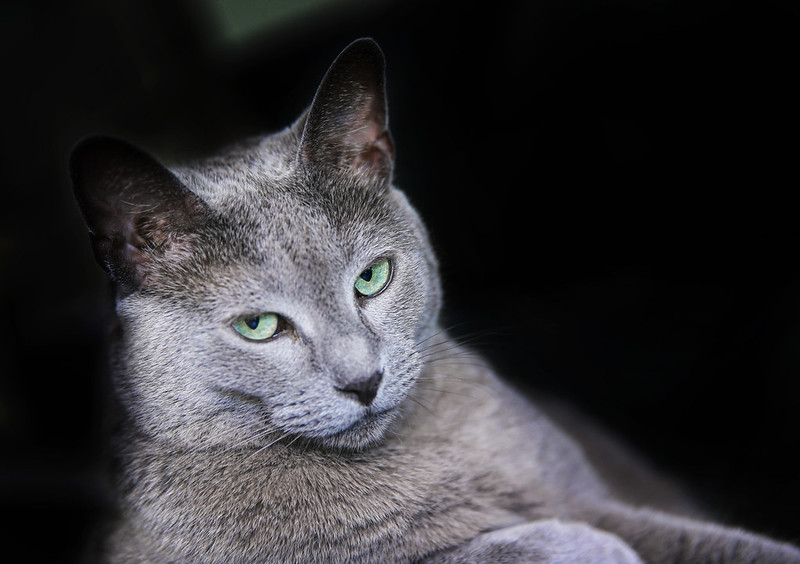
Quiet, graceful, and wrapped in a shimmering silver-blue coat, the Russian Blue has long been admired for its beauty—and quietly celebrated for its allergy-friendliness. Many Russian Blues naturally produce lower levels of Fel d 1 protein, making them one of the top go-to breeds for allergy-prone cat lovers. Their thick, plush double coat doesn’t shed as much as you’d expect, and it tends to trap dander rather than release it into the air, keeping sneeze levels lower in the home.
This breed traces its roots back to the cold northern port of Arkhangelsk, Russia, where it developed a dense coat to survive freezing temperatures. Russian Blues made their way to Europe in the 1800s and became known not just for their looks, but for their quiet intelligence and sweet, observant nature. Despite their luxurious appearance, they’re a low-maintenance breed. Their coat requires only occasional brushing, and they’re naturally clean and tidy cats—traits that help reduce allergens in your environment.
What makes them truly special is their calm, loyal temperament. Russian Blues are affectionate but not clingy, and often choose one or two people to follow around like velvet shadows. They’re content to quietly observe, chirp hello, and settle nearby without overwhelming your space. Their big green eyes seem to study you with gentle curiosity, and their purr is soft and comforting. If you’re hoping for a peaceful, low-allergen companion that adds elegance to your life, the Russian Blue is both beauty and relief in one silvery bundle.
7. Cornish Rex
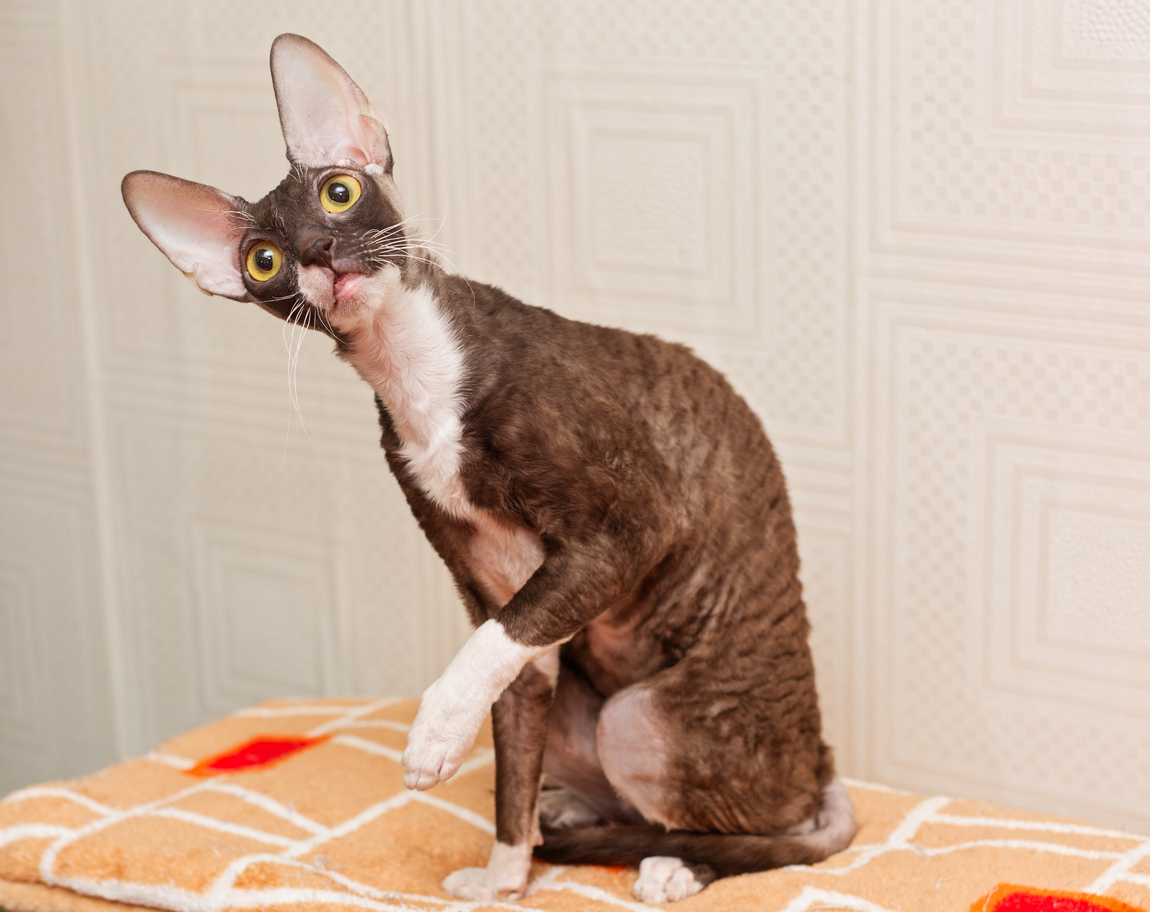
The Cornish Rex doesn’t look—or feel—like your average cat. With its tight waves of curly fur, long legs, and giant bat-like ears, it’s a walking conversation starter. But that funky coat does more than turn heads—it makes the Cornish Rex one of the most allergy-considerate cats around. Unlike other breeds, they have only a single layer of soft down hair, with no outer coat to shed dander all over your furniture. Many also produce less Fel d 1 protein, giving your sinuses a break while still giving you all the cat companionship you crave.
This breed began in Cornwall, England in 1950, when a kitten named Kallibunker was born with a unique curly coat. Breeders preserved the gene, and the Cornish Rex quickly gained fans for both its looks and low-maintenance fur. Their coat rarely sheds and doesn’t require much brushing—just a gentle wipe-down now and then to keep oils in check. They’re so light on grooming and shedding that many allergy sufferers report fewer symptoms living with them than most traditional cats.
But what really sets them apart is their nonstop energy and clownish charm. Cornish Rexes love to leap, race, and explore every corner of your house like it’s a jungle gym. They’re affectionate, attention-seeking, and thrive on being involved in whatever you’re doing—even if that means typing with a cat draped across your shoulders. For people who want a low-allergen cat with a huge personality and a permanently playful vibe, the Cornish Rex is an irresistible little jester in a velvet coat.
8. Lykoi

Have you ever wanted a cat that looks like it wandered in from a Halloween movie—but turns out to be a total sweetheart? Meet the Lykoi, affectionately known as the “werewolf cat.” With its sparse, patchy coat and naturally low-shed fur, the Lykoi is one of the most visually striking—and surprisingly allergy-considerate—breeds around. Thanks to their thin, roan-pattern coat and minimal underfur, they release far less dander into the air. Many allergy-sensitive owners find them much easier to tolerate than traditional breeds.
The Lykoi’s hauntingly cool look isn’t the result of designer breeding—it’s the product of a natural genetic mutation discovered in a feral colony in Tennessee in 2011. The mutation affects hair growth and structure, leading to the breed’s signature “molting” look, with thin patches around the eyes, nose, and mouth that give it its werewolfy vibe. Despite the spooky exterior, their coat is soft, low-maintenance, and lacks the volume to carry much allergen. Occasional brushing and gentle bathing help keep both skin and sinuses clear.
But behind the eerie eyes is an affectionate, dog-like companion that adores human attention. Lykoi are playful, inquisitive, and loyal—they’ll chase toys with wild energy and then curl up close for a nap. They’re known for bonding closely with their families and showing off their goofy, loyal personalities once they’re comfortable. If you’ve ever wanted a cat that’s hypoallergenic-ish, off-the-charts unique, and a total conversation piece, the Lykoi might be your dream creature of the night.
9. Ocicat
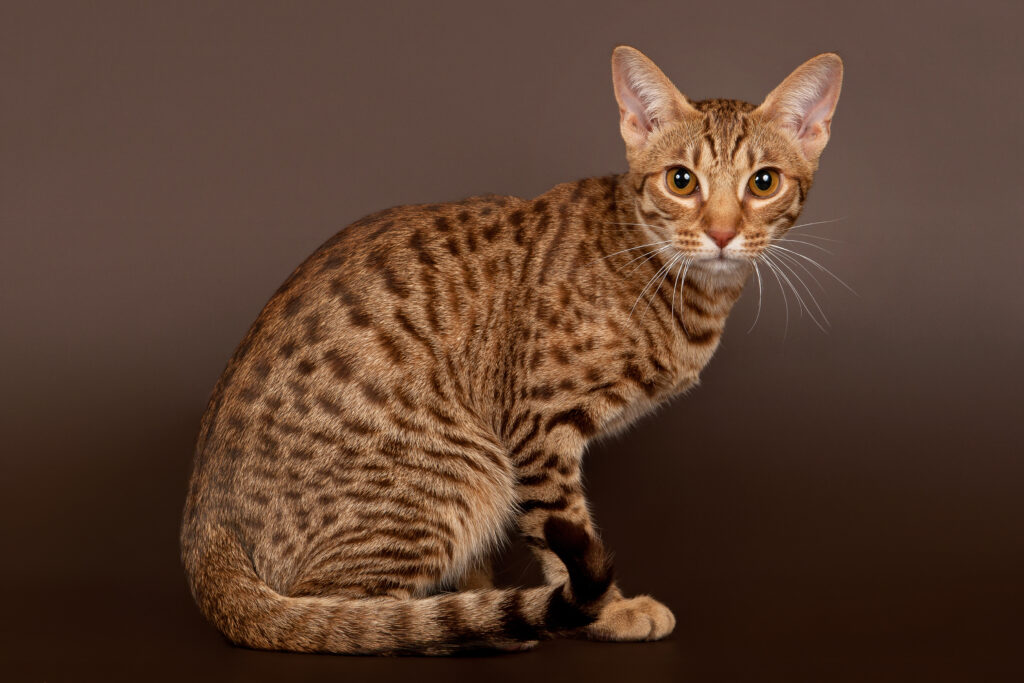
With its wild, spotted coat and muscular build, the Ocicat looks like it just stepped out of the jungle—but it’s 100% domestic and surprisingly easy on allergies. Though not officially labeled hypoallergenic, Ocicats have short, tight coats that shed minimally and don’t trap much dander. Their grooming habits are tidy, and many allergy-sensitive owners report fewer symptoms with this breed. While Fel d 1 levels vary cat to cat, their sleek fur and lower-maintenance shedding make them a solid pick for those with mild sensitivities.
The breed originated in the 1960s from an accidental pairing—breeder Virginia Daly crossed a Siamese and Abyssinian, then added American Shorthair to the mix, and out came a kitten that looked like a miniature ocelot. The look was so striking that breeders ran with it, and the Ocicat was born. Despite the exotic appearance, their coat is low-fuss: no undercoat means less matting, less dander build-up, and fewer allergens floating through the air. A quick brush once a week is all they need to stay in top form.
What really wins people over is the Ocicat’s outgoing, dog-like personality. These cats are social, smart, and love to be the center of attention. They can be trained to fetch, walk on a leash, and even respond to commands. They thrive in active households and love being part of a pack, whether it includes people, other cats, or even dogs. For allergy-sensitive homes that want a bold, playful companion with a wow-factor look and manageable coat, the Ocicat delivers wild style with a domesticated heart.
10. Siamese
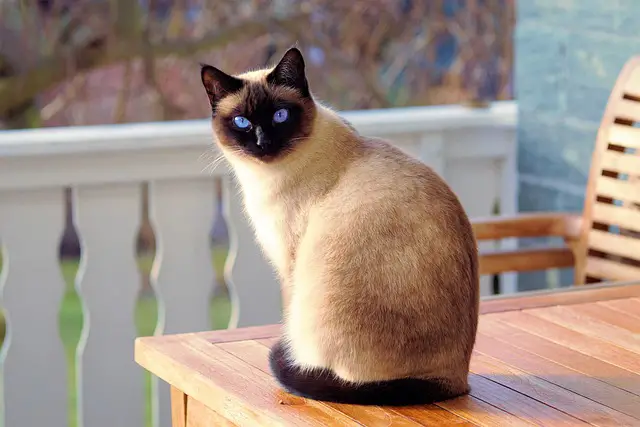
The Siamese is iconic—those piercing blue eyes, elegant lines, and loud, opinionated meows are unmistakable. But aside from being a conversation starter, the Siamese is also one of the more allergy-considerate breeds. They tend to produce less Fel d 1 protein compared to other cats, and their ultra-short, close-lying coat sheds less and spreads fewer allergens around your home. While not completely hypoallergenic, they’re a strong option for sensitive households looking for love without the sniffling side effects.
This ancient breed hails from Thailand, formerly known as Siam, where they were once considered sacred and kept by royalty. They were introduced to the Western world in the late 1800s and quickly became one of the most popular and recognizable cat breeds. Their sleek, muscular bodies and color-point patterns are just part of the appeal—their grooming needs are minimal, and their coats require little more than an occasional rub with a soft cloth or grooming mitt. Their tidy habits and low dander output only add to their allergy-friendly reputation.
What truly makes a Siamese unforgettable, though, is their personality. These cats are deeply attached to their people and are not shy about making their feelings known. They’ll follow you around, “talk” to you constantly, and insist on being part of the action—from cooking dinner to brushing your teeth. They’re intelligent, emotional, and crave connection. For allergy sufferers who want a close, communicative bond with their cat and minimal sneeze risk, the Siamese is equal parts elegance and energy—always with something to say.
11. LaPerm

With their tousled curls and affectionate personality, LaPerms are the feline equivalent of a cozy hug—and for allergy sufferers, they come with a delightful twist: they’re often easier to live with. This breed’s loose, springy curls hold onto dander and hair instead of releasing it into the air, meaning fewer allergens are floating around your home. Many owners with mild to moderate allergies report fewer symptoms with LaPerms, even though they’re not officially labeled hypoallergenic.
The LaPerm’s story began in Oregon during the 1980s, when a bald kitten named Curly suddenly developed a coat of soft, bouncy waves. The look was so endearing—and the temperament so sweet—that breeders preserved the gene and developed what is now one of the most distinctively textured cats around. Whether long-haired or short, their coat rarely mats, sheds lightly, and requires minimal grooming. A quick brush once a week is usually enough to keep them neat and allergen-light. Their skin also tends to produce less oil, meaning fewer irritants overall.
But the real charm of the LaPerm lies in its personality. These cats are friendly, curious, and love being part of the action without being overwhelming. They’re gentle enough for families, affectionate without being clingy, and always up for a bit of mischief. Expect head boops, lap snuggles, and a sweet nature that melts even the most hesitant heart. For those who want a hypoallergenic-ish cat with a one-of-a-kind look and a naturally loving vibe, the LaPerm is a curly little joy.
12. Burmese
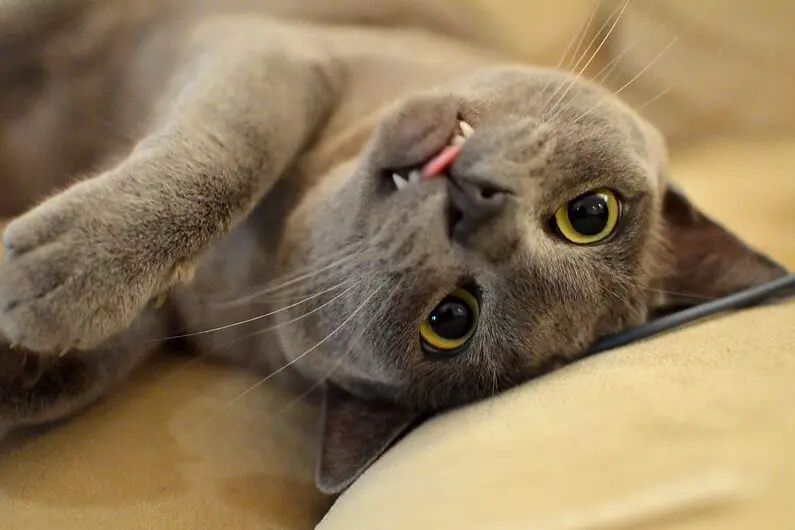
With their soulful golden eyes, rounded features, and plush, satin-like coat, Burmese cats are pure snuggle material—and a gentle surprise for allergy sufferers. While they’re not officially classified as hypoallergenic, Burmese cats tend to shed very little and produce lower levels of Fel d 1 protein than many other breeds. Their short, tight coat lies close to the body and doesn’t kick up much dander, making them a more manageable choice for sensitive households craving some feline affection.
This breed’s origins trace back to the 1930s, when a small brown cat named Wong Mau was brought from Burma (now Myanmar) to the U.S. and bred with a Siamese. The result? A sturdier, rounder, and more mellow cat with a luxurious coat and a charming, people-oriented personality. Despite their sleek appearance, Burmese are lower-maintenance than you’d expect—occasional brushing and regular petting (which they’ll beg for) are enough to keep them tidy and reduce allergen buildup. They also tend to be fastidious groomers, which helps limit dander in the environment.
Burmese cats are often described as dog-like in their loyalty. They love being with their humans, whether curled in your lap, sleeping beside you, or greeting guests at the door. They’re social, gentle, and often follow you from room to room like a soft, purring shadow. For allergy sufferers who want a deeply affectionate, low-shed companion without the high-maintenance fluff, the Burmese is a velvet-coated sweetheart who delivers love without the sniffles.
13. Turkish Angora

Have you ever owned a cat so stunning you could barely believe it didn’t come with a lint roller attached to your hip? Meet the Turkish Angora—a silky, longhaired beauty that defies the allergy odds. With a fine, single-layer coat and a reputation for producing less Fel d 1 protein, this ancient breed is often easier for allergy-prone cat lovers to live with. Unlike double-coated cats, Angoras don’t have a dense undercoat to trap dander and shed excessively, making them lighter on both allergens and clean-up.
This breed dates back centuries and is one of the oldest naturally occurring cat breeds in the world. Originating in the Ankara region of Turkey, the Turkish Angora was once considered a national treasure—and it’s easy to see why. These cats are graceful, intelligent, and carry themselves with a kind of feline royalty. Their coat, while long and luxurious, rarely tangles and doesn’t require daily brushing. Just a gentle weekly combing will keep them looking photo-ready and help minimize airborne allergens.
But don’t let their angelic looks fool you—these cats are playful, confident, and love to be in charge. They’re social without being clingy and have a tendency to perch high up, surveying their kingdom with sparkling, often odd-colored eyes. If you’ve ever dreamed of owning a longhaired cat but assumed your allergies made that impossible, the Turkish Angora is a graceful exception. They’re beauty, brains, and breathability all rolled into one silky, sweet package.
14. Singapura
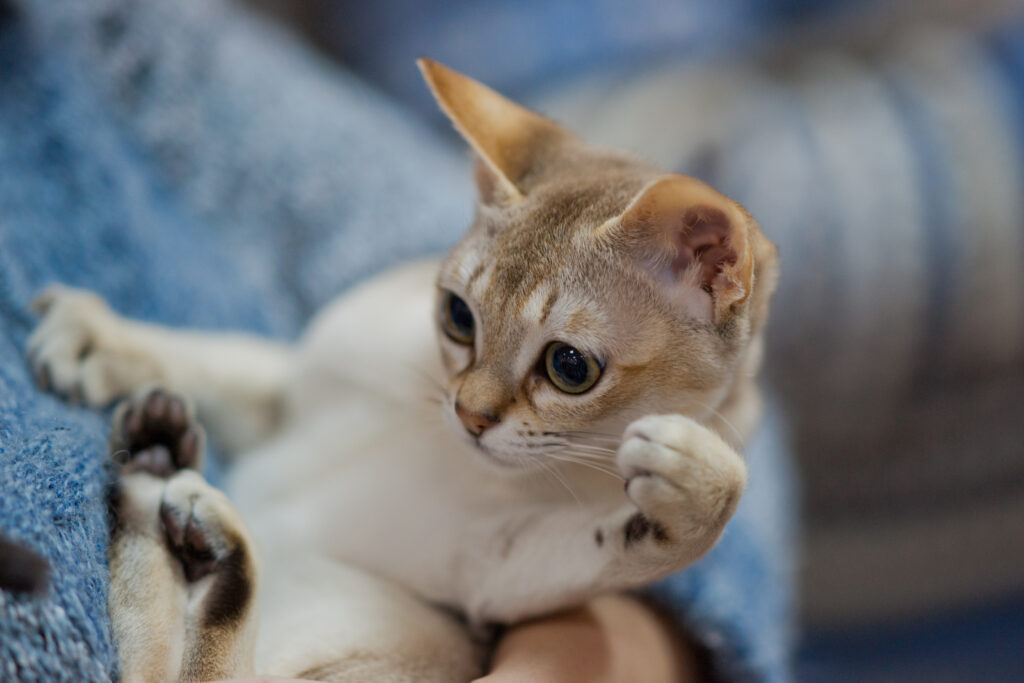
The Singapura may be the smallest cat breed in the world, but it brings a big dose of charm—and a surprisingly light allergen impact. Weighing just 4 to 8 pounds, these pint-sized purr machines have short, fine coats that shed very little and release minimal dander. Their small bodies and tidy grooming habits help keep allergen levels lower than many larger, fluffier breeds. While not officially hypoallergenic, their low-maintenance coats and mild Fel d 1 output make them a great match for sensitive cat lovers looking for something petite and playful.
This breed originated on the streets of Singapore, where it developed as a natural breed before being brought to the U.S. in the 1970s. Their sepia-toned fur, ticked tabby pattern, and oversized eyes give them an alert, elfin look. With no thick undercoat and a coat that lies sleek against the body, Singapuras require minimal brushing and are generally very clean, reducing the buildup of allergens in your home. They’re ideal for allergy-prone families who want a compact companion that doesn’t leave a trail of fur behind.
Despite their size, Singapuras are fearless, funny, and endlessly curious. They love to climb, explore, and insert themselves into every corner of your life—from your bookshelves to your laundry baskets. They bond closely with their humans and are happiest when involved in your daily routines. If you want a cat that’s light on allergens, big on personality, and just the right size to fit in your lap (or hoodie), the Singapura is a tiny treasure with a mighty heart.
15. Tonkinese
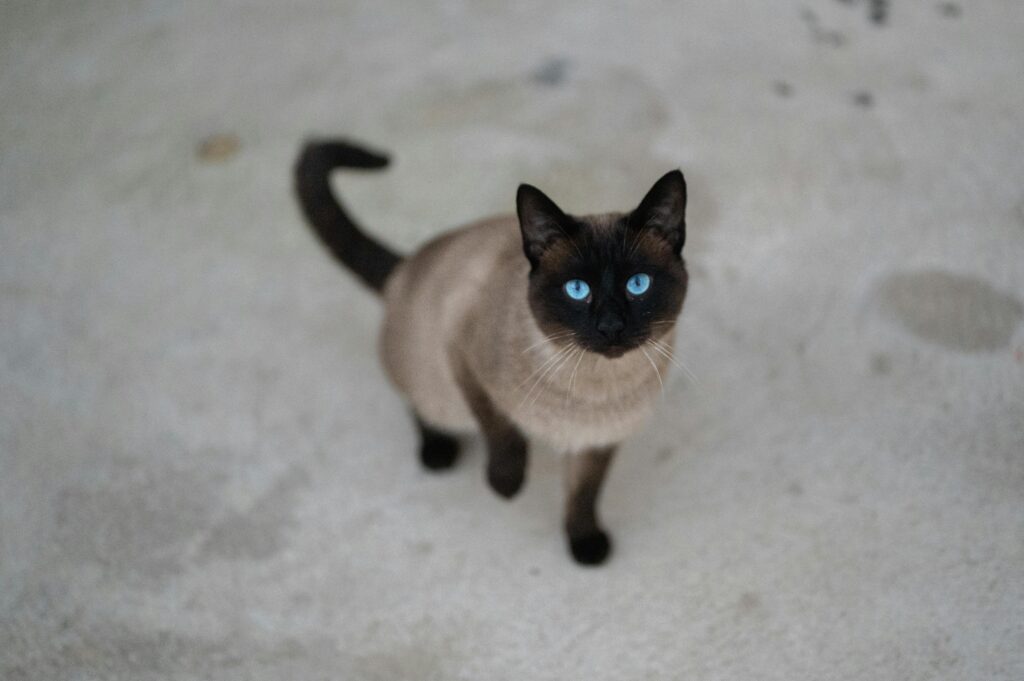
The Tonkinese is a charming blend of the Siamese and Burmese—two breeds already known for their lower Fel d 1 production—and it brings the best of both worlds for allergy-conscious cat lovers. With a short, silky coat that hugs the body, Tonkinese cats shed very little and don’t hold much dander or saliva. While not officially hypoallergenic, they’re often well-tolerated by those with mild sensitivities, thanks to their light coat, tidy grooming habits, and naturally lower allergen load.
Bred in the 1960s to combine the sociable, chatty nature of the Siamese with the cuddlier calm of the Burmese, the Tonkinese quickly became beloved for its affectionate and people-oriented personality. Their coats come in a variety of soft colors and three distinct patterns—solid, mink, and point—all of which require minimal upkeep. A weekly brushing or a quick rub with a damp cloth keeps their coat glossy and allergens under control. Plus, their playful curiosity and overall cleanliness make them a great choice for families and allergy-aware homes alike.
But it’s their temperament that seals the deal. Tonkinese cats are affectionate, interactive, and incredibly social—they’ll ride on your shoulder, greet guests at the door, and insert themselves into any conversation. They thrive on attention and form strong bonds with their people, often acting more like dogs than cats. For allergy sufferers who want a low-shed companion with an outgoing spirit and silky-soft snuggles, the Tonkinese is a lovable overachiever who won’t leave you reaching for tissues.
Bonus Fun Fact:

Did you know some hypoallergenic cats are actually a result of completely random mutations? Breeds like the Devon Rex, Cornish Rex, and even the Lykoi (yes, the werewolf-looking one) started from surprise kittens with unusual coats—and ended up revolutionizing allergy-friendly cat ownership.
Pro Tips for Allergy-Prone Cat Lovers:
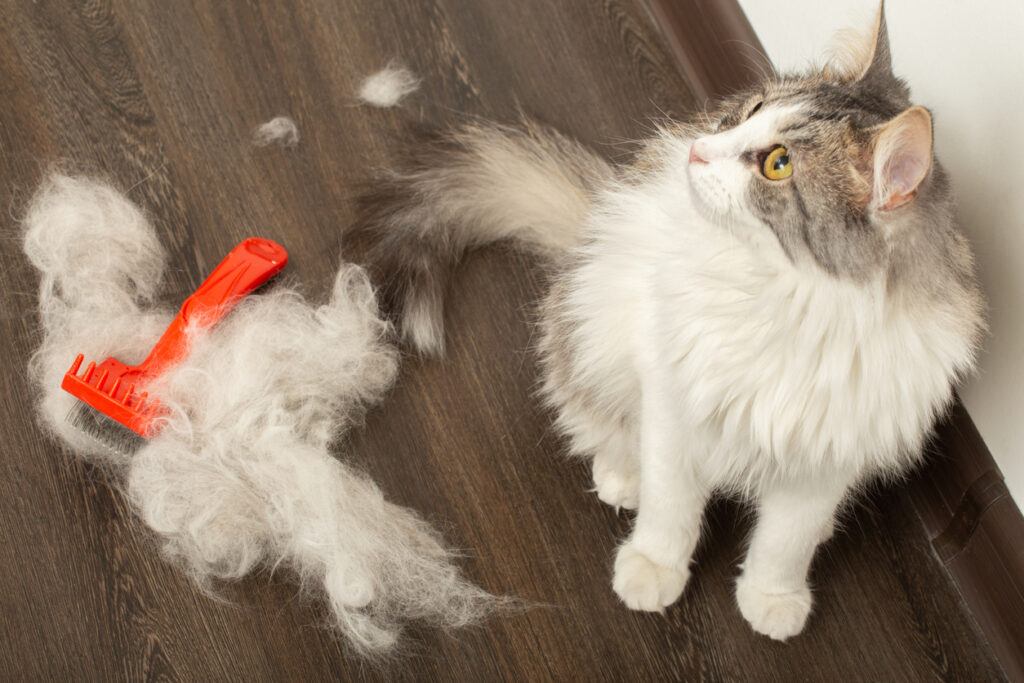
Even if you get one of these breeds, there are a few smart ways to reduce allergens at home: use HEPA filters, vacuum frequently with a pet-specific vacuum, wash your hands after cuddles, and bathe or wipe down your cat with a damp cloth weekly. A little prevention goes a long way toward keeping the sniffles at bay.
Final Thoughts:
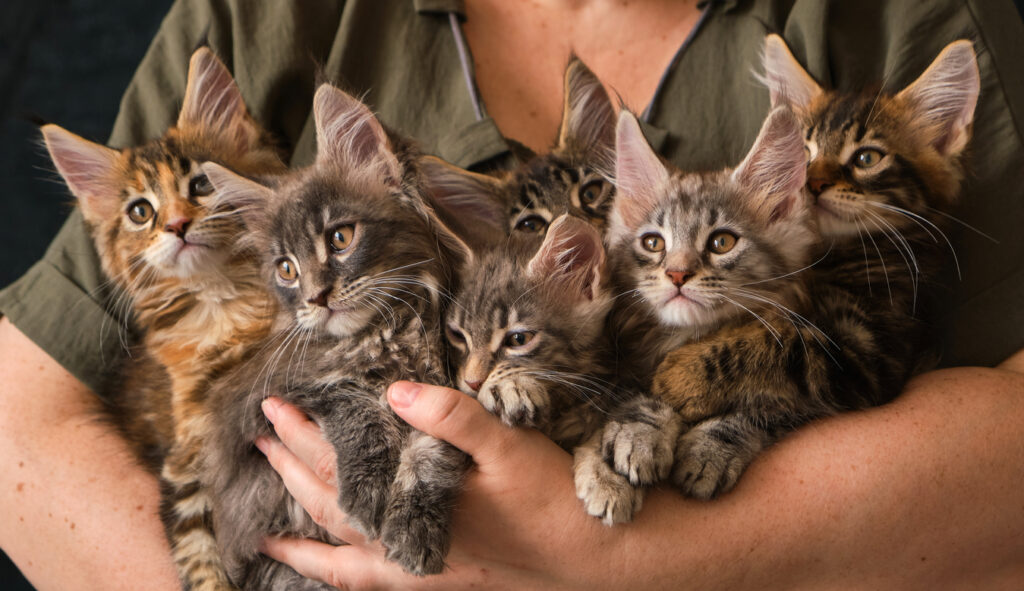
No cat is completely hypoallergenic—but these 15 breeds come impressively close for many allergy-sensitive people. With the right match and some smart home habits, you don’t have to miss out on the joy, comfort, and companionship of having a cat. Whether you’re into curls, elegance, or wildcat vibes, there’s a breed on this list that’s ready to curl up beside you—and keep your tissue box full… of dust, not tears.


